

These days, making decisions has become quite an epic saga. A simple Google search can send us spiraling into an abyss of information. After a clickathon on par with a Netflix binge, we find ourselves not enlightened but lost.
Popular writer and psychologist Barry Schwartz reveals the classic paradox of choice in his research: While more choices theoretically lead to better outcomes, the overwhelming array of options often induces anxiety, confusion, and dissatisfaction. All icky things that analysis paralysis brings.
No need for concern, though, fellow decidophobics! This practical guide aims to dissect the roots of analysis paralysis and, armed with a balanced understanding, provide actionable strategies to overcome it and break free from the cycle of indecision! 🧞
- What is Analysis Paralysis?
- What Causes Analysis Paralysis?
- Conquer Analysis Paralysis: 10 Solutions to Get You Unglued
- 1. Set clear goals before making decisions
- 2. Prioritize high-impact decisions
- 3. Bind yourself to a realistic timeline
- 4. Limit information
- 5. Try making quick, gut-based decisions
- 6. Delegate decision-making authority
- 7. Embrace agile practices for team decisions
- 8. Explore resources beyond your own mental faculties
- 9. Use decision-making frameworks to analyze faster
- 10. Work on self-confidence
- Good to Know: The Other Side of Analysis Paralysis
What is Analysis Paralysis?
Be it a kid at the candy store or a tech enthusiast buying a new gadget, the burden of choice is always heavy. This seems like a harmless side effect of the highly discerning potential of the human brain, but what if the process starts taking a toll on you?
If you’ve ever found yourself completely overwhelmed by extensive options or data, struggling to decide for fear of making the wrong choice, you’ve experienced what’s known as analysis paralysis.
It’s a mental state where the fear of making an incorrect decision leads to no decision at all. This phenomenon is a relatively common roadblock that hinders progress, especially in professional settings.
Picture a team trying to choose a new logo for a rebrand. They dive deep into color psychology, font styles, and cultural associations, creating an extensive list of logo suggestions. Meetings multiply, opinions clash, and the pursuit of perfection becomes a begrudging loop of analysis while the fear of making the wrong choice paralyzes the team.
How bad is analysis paralysis?
As you strive for perfection, it’s natural to want all the information at your disposal before making a choice. However, this can lead to an uncomfortable information overload or trigger an endless quest for data. In business and project management teams, analysis paralysis could also lead to:
- Missed deadlines due to decision-making delays
- Lack of progress due to unproductive use of time
- Increased costs because of potential wait times
- A lingering state of unhappiness and frustration in the workspace
Knowing when to stop analyzing data and start making a decision is crucial here. This isn’t just about you but the project’s momentum, the team’s morale, and, ultimately, the success of your collective efforts.
What Causes Analysis Paralysis?
It’s okay to think things through, but if you constantly find yourself stuck, it’s time to find out why. Well, it’s not as complicated as it might seem. The root cause is often a psychological issue such as:
- Fear of making the wrong decision: You want your decisions to be intentional, and the fear of making a poor choice can stop you dead in your tracks. You’re worried about the potential negative consequences, which causes over analyzing every single option
- Overwhelmed with information: We’re all bombarded with information in today’s digital age. Having too much data can make it challenging to decide what’s relevant and what’s not, leading to a standstill
- Desire for perfection: If you’re a perfectionist, you probably want to consider every possible outcome before deciding. But that’s a one-way ticket to constant fault-finding and anxiety
- Lack of clear objectives: Without clear objectives, it’s hard to know what to prioritize. This lack of direction can cause you to overanalyze your options aimlessly
Conquer Analysis Paralysis: 10 Solutions to Get You Unglued
After you figure out the nature of your analysis paralysis, the next important thing is to learn how to conquer it. Luckily, you’re not alone in this. Analysis paralysis is a common stumbling block, but our 10 time-tested techniques can help you find a way out!
Hint: You’ll have a little helper here—ClickUp! 😉
ClickUp is a work and productivity management solution with built-in features to help soothe the decision-agitated brain. We’ll demonstrate how to use the software to beat analysis paralysis!
1. Set clear goals before making decisions
Ask yourself: What’s the most important idea behind a specific decision-making task?
It could be a specific goal, like growing your skills, or a broader value, such as launching a product successfully or achieving a work-life balance. Either way, you should write it down and make a habit of revisiting it every time you feel an analysis-paralysis situation looming. This realigns your mindset and stops you from wasting time on less significant tangents, be it in your professional or personal life.
The ClickUp Goals feature is one of the easiest ways to keep your primary objectives in sight and avoid analysis paralysis. It allows you to set clear timelines, measurable targets, and deadlines for decision-making tasks. Plus, with automatic progress tracking, it’s easier to catch yourself if you end up spending too much time on a particular task.
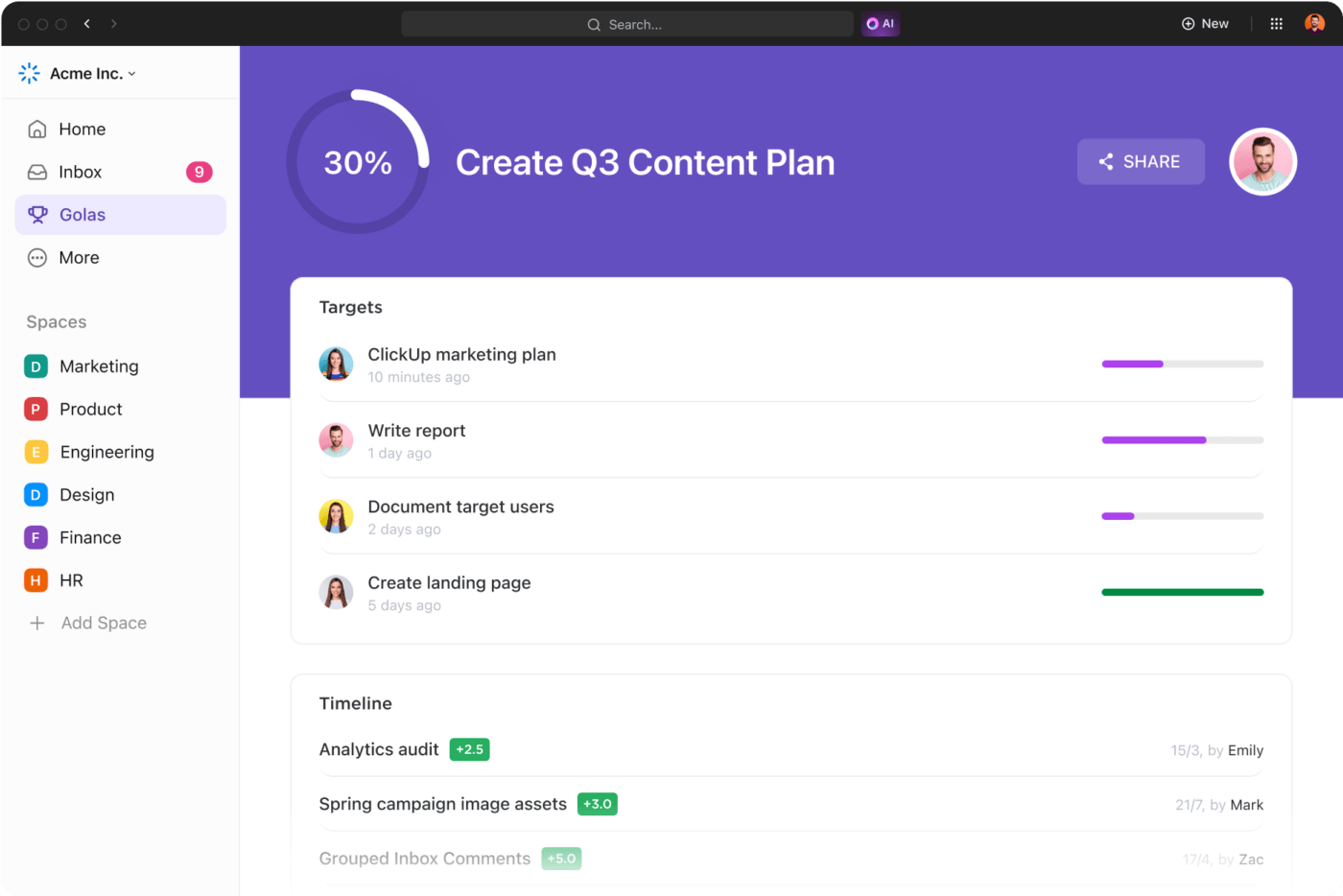
When making a tough choice, don’t overthink. Just ask yourself: Which option aligns with what matters to you the most? If you’re wavering way more than you’d like, check out the SMART goals framework, a handy tool to ensure your goals steer you in the right direction. SMART stands for:
- Specific
- Measurable
- Attainable
- Relevant
- Time-bound

Need a head start? The ClickUp SMART Goals Template allows you to map your goals right away!
2. Prioritize high-impact decisions
Don’t let minor decisions (like picking the design theme of a PowerPoint presentation?) consume your time and energy. You’ll have to let go of the idea that every decision matters equally. It doesn’t.
After setting the goals, identify the priority decisions that will have the greatest impact on what you’re trying to achieve.
How do you prioritize efficiently?
The first thing that you’d love is the ClickUp Task Priorities tool. It lets you mark how important each decision or task is through four color-coded flags. Doing that makes spotting and concentrating on the more critical tasks easier.

If you consider yourself an absolute overthinker, the ClickUp Priority Matrix Template can help. It lets you identify urgent tasks and visualize their relative importance on a digital whiteboard, ensuring better prioritization.
3. Bind yourself to a realistic timeline
Let’s get a bit science-y with time—Parkinson’s Law says that work fills the time you give it. If you allow an hour for a task, it takes an hour. Give it 10 minutes, and it magically gets done in 10. This, without a doubt, applies to decisions as well.
Set a time limit, and you’ll find yourself making decisions more quickly.
By setting achievable deadlines, you create a sense of urgency, which aids in curbing overthinking and propels you toward decisive action.
With ClickUp, you can seamlessly manage decision-making deadlines by using Due Dates. Just set a time and day for task completion, and you’ll receive timely notifications when tasks go past their due dates, ensuring you stay on top of your schedule. Meanwhile, ClickUp Milestones act as checkpoints to monitor your progress, offering opportunities for course correction.
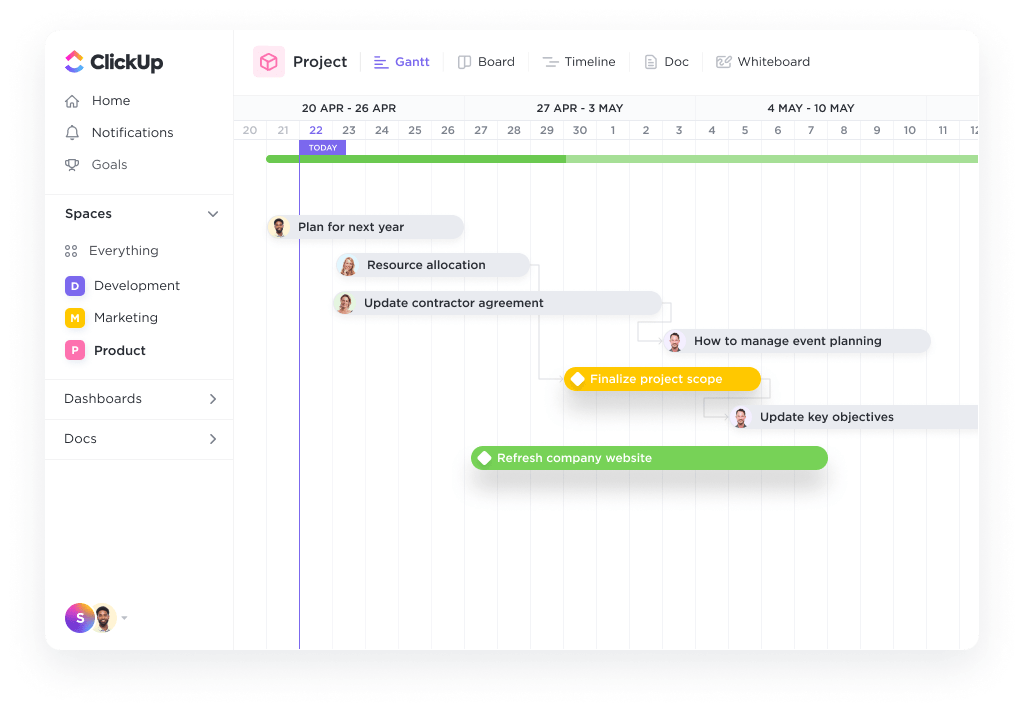
4. Limit information
While compiling this list for you, we began with 20 tabs open, narrowed it down to 15, and eventually settled on just five. If we had stuck with all 20, this guide likely wouldn’t have materialized. Here’s what helped us, and it might help you as well:
- Absorb the decision-making space: Know what you’re looking for before diving into research. This will help you stay focused
- Limit information sources: Stick to a few trusted sources depending on the magnitude of your decision. For example, if you’re looking for raw material suppliers, you’d mainly compare the pricing of geographically compatible vendors or those with the best quality ratings
- Use ClickUp timer or similar tools: Don’t allow yourself the luxury of endless time for brainstorming and decision-making. You can use time management tools within ClickUp for support
- Trust your judgment: You’re capable of making good decisions because you care about the end goal. Once you have sufficient information, trust your gut and make the call
As wisely expressed by Wei Sun, a partner at Digital Craftsman Venture Partners: “My mission isn’t to have all of the data—I just look to have enough data to defend my decision.”
5. Try making quick, gut-based decisions
You must’ve heard of speed dating—well, why not explore speed decision-making? 💗
If you experience decision fatigue, try making decisions quickly without overthinking. It might seem scary initially, but trust us when we say it gets easier with practice. Consider:
- Choosing your next Netflix adventure instinctively, without reading reviews
- Deciding on your outfit for the day without caring about what’s trendy
- Selecting a new recipe to try for dinner without spending hours comparing options
- Inviting an employee for collaboration without micro-analyzing their performance reports
Making these small choices can enhance your comfort level with more significant decisions.
6. Delegate decision-making authority
Delegating decision-making isn’t abdicating responsibility but a strategic move to stop analysis paralysis. Don’t feel pressured to make every decision yourself. Trust your team, share the load, and watch productivity soar!
Simplify the team decision-making process by leveraging the ClickUp Delegation of Authority Matrix Template. Its nine Custom Fields and three views help you assign tasks and create a clear information hub about who handles what. Keep an eye on decisions in progress, receive alerts about potential issues, and celebrate milestones without a hitch!
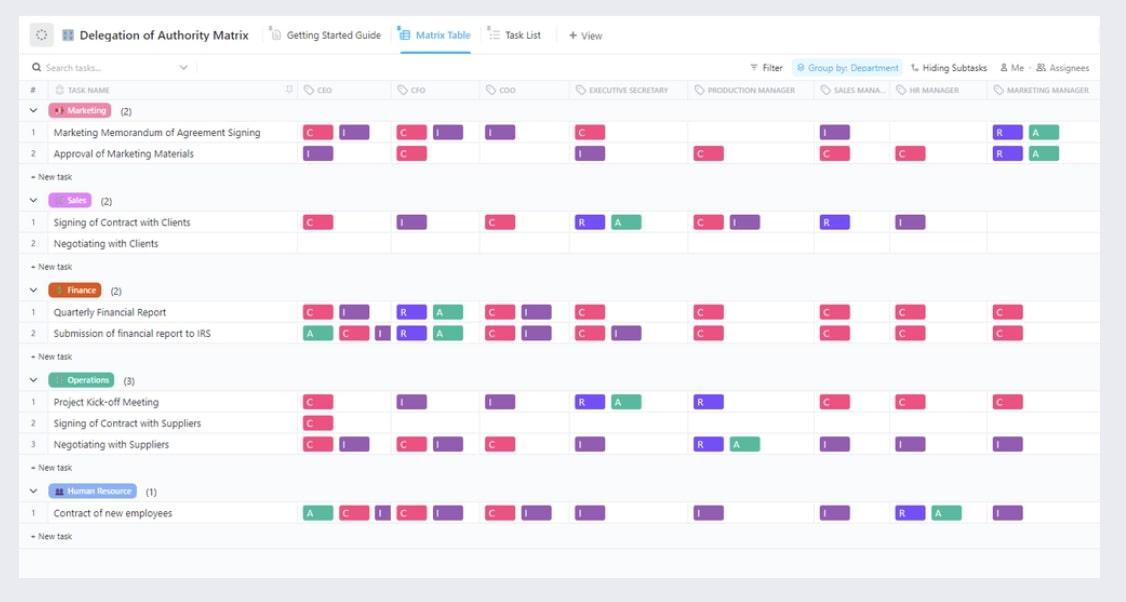
Choose your delegates wisely, considering their strengths, expertise, and judgment. Provide them with clear guidelines to ensure they’re fully equipped to make informed decisions.
7. Embrace agile practices for team decisions
Agile is a project management methodology that promotes a transparent decision-making process over hierarchical approaches. This iterative approach involves analyzing problems in small, low-impact settings, reducing the pressure of getting everything perfect the first time. Plus, team stakeholders have greater visibility over decision-making sessions, which prevents analysis-paralysis scenarios.
Here are some ways to harness agile practices for making collaborative choices:
- Break down projects to simplify decision-making variables and keep progress steady
- Don’t strive for perfection right away—improve and refine processes as you progress
- Regularly check in with your team, collect feedback, and reassess and adjust plans as necessary
- Prioritize team tasks that deliver the most value to maintain momentum and motivation
Agile practices are typically used by software development teams, but many non-software businesses use them to feel confident about their choices.
Unsure where to begin? ClickUp’s Agile Suite can be your perfect companion! From coordinated decision-making to automatic reporting, it’s ideal for hassle-free collaboration with stakeholders! The ClickUp Agile Project Management Template is another great facilitator of information-backed analysis and continuous improvement.
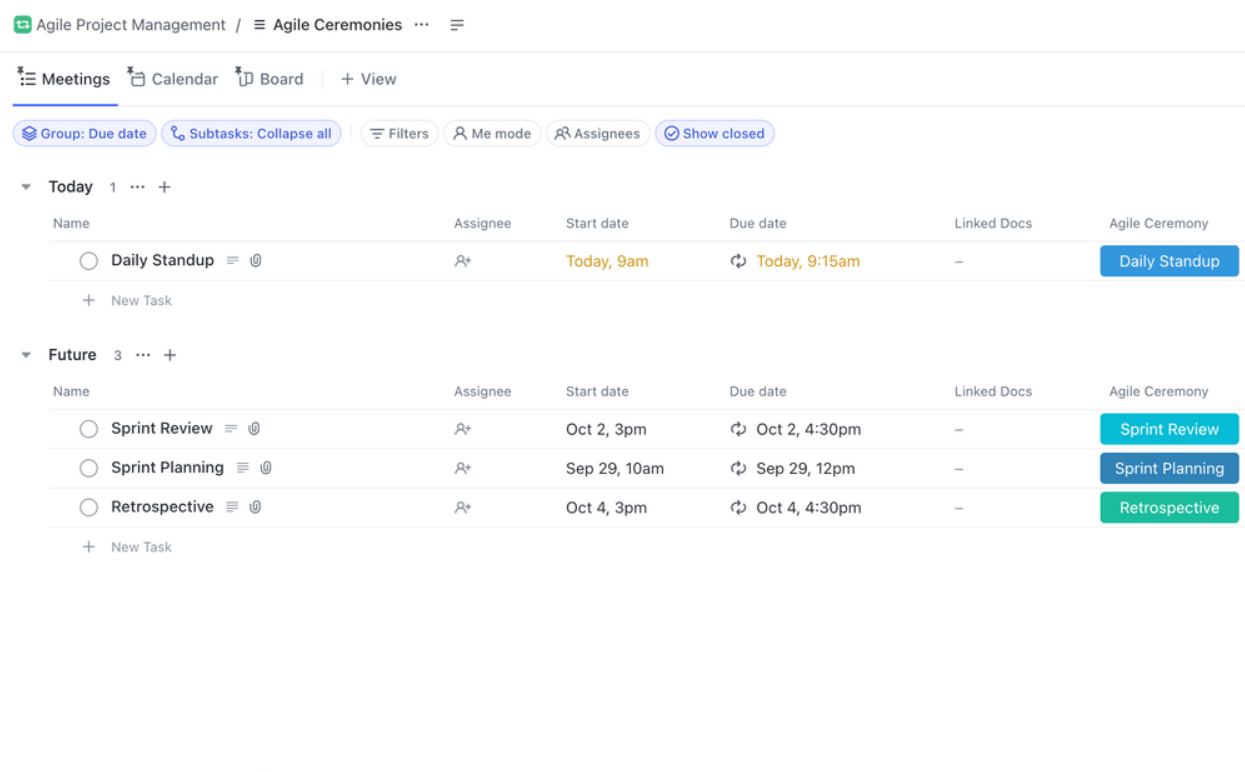
8. Explore resources beyond your own mental faculties
Studies suggest that friends, even strangers, can predict our future satisfaction with a decision better than we can. When you’re stuck on a decision, asking anyone for their opinion can work.
We call this the “wisdom of the crowd‘” approach, which can give your brain a much-needed break. It involves pooling knowledge and insights from various stakeholders to reach a decision, although you’re still the one calling the shots.
If you find yourself overthinking, set up a chat with a coworker, boss, or friend for some helpful suggestions.
But if we’re really going for external insights, let’s not forget about the new-age wonder of decision-making—artificial intelligence (AI). You’ll find several AI tools that enable you to explore new angles when battling analysis paralysis.
Take ClickUp AI, for instance! Picture yourself in the thick of decision-making, stuck on drafting a boring marketing case study—ClickUp AI steps in to simplify the process. Use its 100+ research-backed prompts to brainstorm new ideas, summarize lengthy data, or generate presentable content.
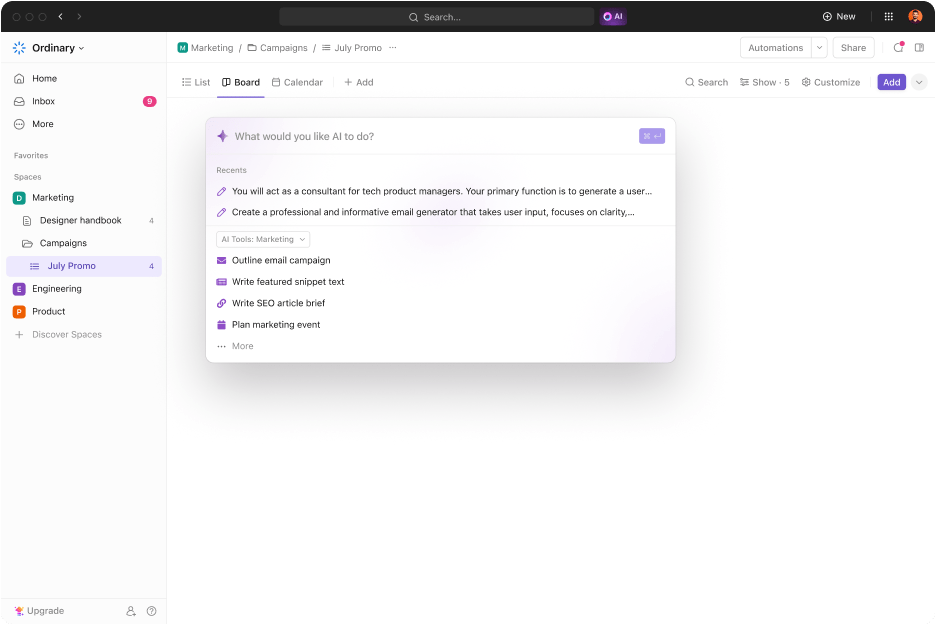
If you tend to feel blocked due to writing tasks, ClickUp’s Write With AI is your solution for swiftly crafting a report, email, content brief, and blog post with consistency and precision.
9. Use decision-making frameworks to analyze faster
Surprisingly, comprehensive decision-making frameworks exist and offer a systematic way to navigate choices, minimizing the risk of being caught in endless analysis loops.
ClickUp, with its array of templates, provides you with ready-made tools to integrate these frameworks into your workflow and have decisive outcomes. Our favorites are the SWOT analysis, PESTLE analysis, and the Eisenhower Matrix.
SWOT analysis
Imagine you’re deciding whether to take on a new project at work. Assessing your Strengths (excellent organizational skills), Weaknesses (limited experience in the niche), Opportunities (potential for skill growth), and Threats (potential time constraints) helps you make an informed decision tailored to your capabilities!
Template to try: The ClickUp Personal SWOT Analysis Template
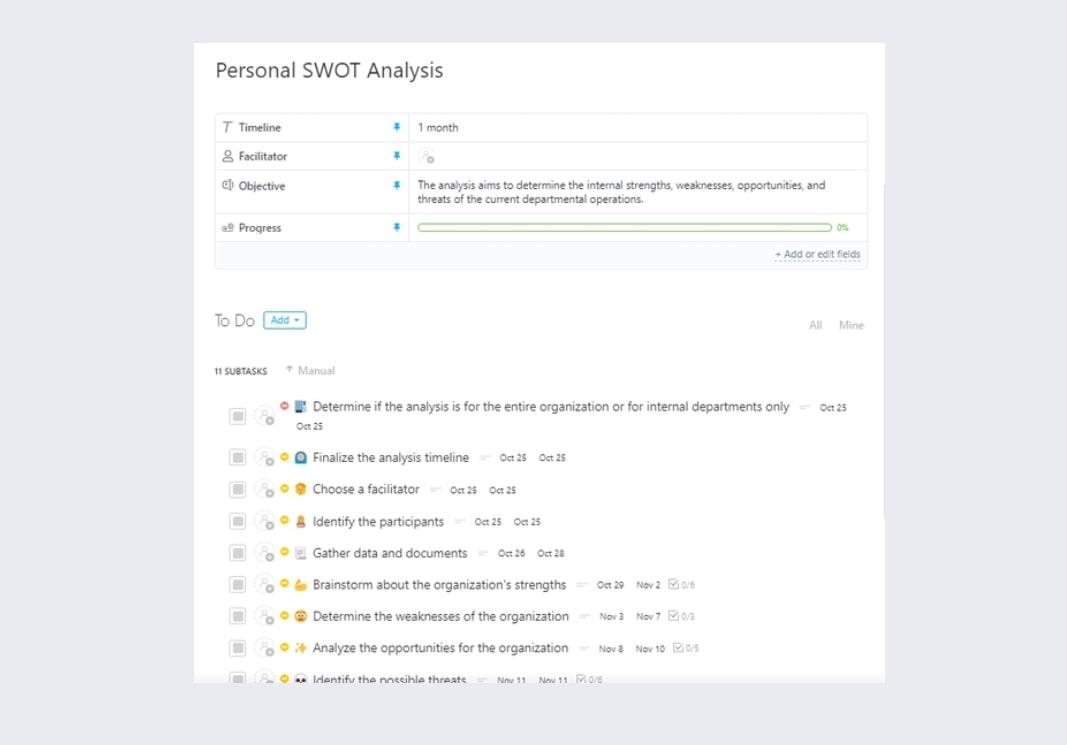
PESTLE analysis
Suppose you’re considering launching a new product. A PESTLE analysis helps you evaluate the broader landscape. For instance, understanding Political factors (regulations impacting your industry), Economic factors (market trends), Social factors (consumer preferences), Technological factors (emerging technologies), Legal factors (regulatory compliance), and Environmental factors (sustainability concerns) provides a comprehensive view for strategic decision-making.
Template to try: The ClickUp PESTLE Analysis Template
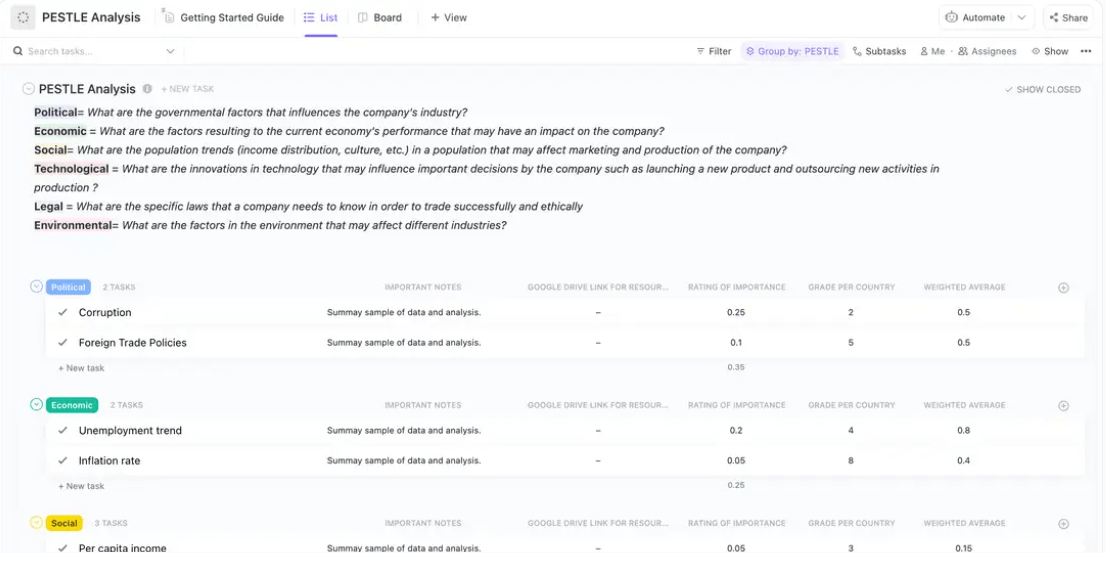
Eisenhower Matrix
Picture a list of tasks, including responding to emails, preparing a presentation, and attending a team meeting. The Eisenhower Matrix helps you prioritize. Tasks in the Urgent/Important quadrant, like a last-minute client request, take precedence, while tasks in the Important/Not Urgent quadrant, such as long-term project planning, can be scheduled for later. This matrix ensures efficient decision-making based on task urgency and importance.
Template to try: The ClickUp Eisenhower Matrix Template
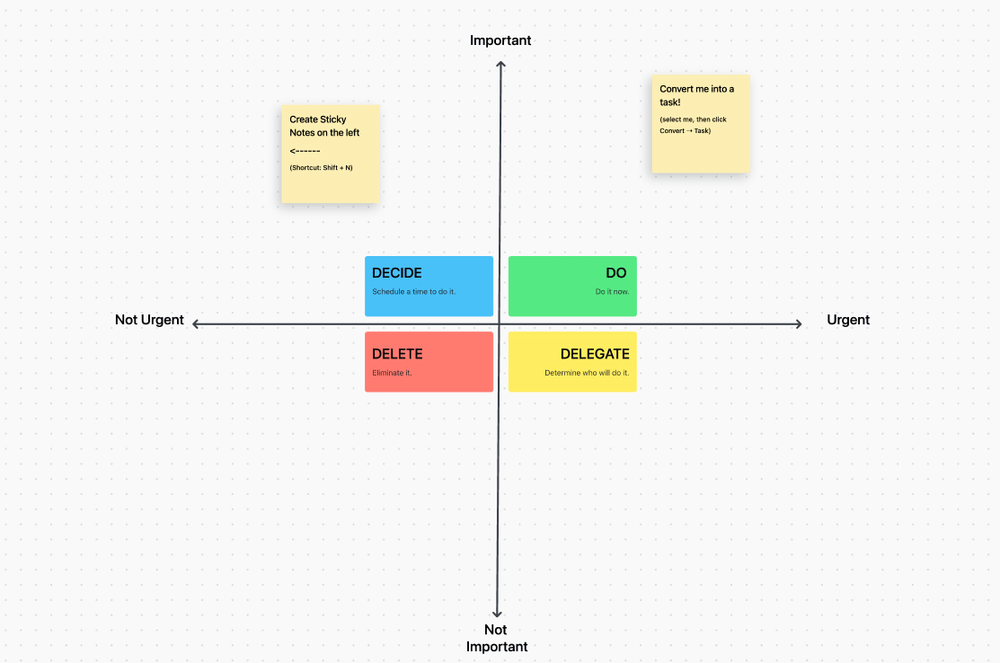
Still feeling shaky about decisions? You can perhaps try the ClickUp Decision Making Framework Document Template—it’s super versatile and keeps everything objective.

10. Work on self-confidence
No one understands you better than yourself. If certain past decisions haven’t yielded the best results, you may get over-critical and start doubting your judgment overall. However, it’s crucial to avoid this mindset and focus on concrete ways to boost your self-confidence. Try to:
- Embrace past mistakes: Instead of dreading making a choice, build compassion for yourself and learn from past mistakes. They’re stepping stones, not stumbling blocks
- Visualize success: Try to imagine the positive outcomes of your decisions. This will help you remain focused and confident
- Seek external validation: Don’t hesitate to seek feedback from people you trust. Constructive criticism can guide you, while compliments boost your confidence
Good to Know: The Other Side of Analysis Paralysis
Analysis paralysis is an unpleasant experience, but on the opposite end of the spectrum lies a state known as ‘utopia myopia.’ In this scenario, decisions are swiftly made with minimal debate, research, or analysis, often driven by an individual’s personal bias.
It’s characterized by a steadfast commitment to a singular viewpoint, resisting the need for additional research or investigation before arriving at a final decision. This approach reflects a limited perspective while aiming for an ideal outcome, completely disregarding alternative viewpoints or potential outcomes—which is as bad as analysis paralysis, in our opinion.
Make Yourself Analysis Paralysis-Free with ClickUp
Balanced decision-making requires an open-minded approach and diverse perspectives, but the resulting analysis paralysis can be a big reason we procrastinate. It’s not about wasting time—it messes with your mindset and confidence levels.
There are ways to pull yourself out of the overthinking loop, but the go-to method is getting mindful. That means smarter schedules, setting time limits, getting comfy with uncertainty, and boosting your self-confidence—you know, the whole deal.
You’ve witnessed how ClickUp makes breaking free from overthinking more structured and efficient. Sign up for free and explore the tools and templates within the platform to combat analysis paralysis effectively.
Don’t forget to trust your instincts, make the call, and see it through! 🤩



Questions? Comments? Visit our Help Center for support.